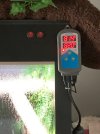I am sorry if this is a stupid question but if you have a closed chamber do you still need to dig up the eggs? Or can you ground hatch them inside the enclosure? Just thanking if I run heat tape underneath to heat the soils. Hope I don't get shot for this question.. lol thanks guys I really appreciate everyone inputs and feedback.! Thanks and happy new year 🎉
You are using an out of date browser. It may not display this or other websites correctly.
You should upgrade or use an alternative browser.
You should upgrade or use an alternative browser.
hatching medium
- Thread starter hydro708
- Start date
You won't be shot... yet...I am sorry if this is a stupid question but if you have a closed chamber do you still need to dig up the eggs? Or can you ground hatch them inside the enclosure? Just thanking if I run heat tape underneath to heat the soils. Hope I don't get shot for this question.. lol thanks guys I really appreciate everyone inputs and feedback.! Thanks and happy new year 🎉
Its a fair question. There are many reasons why that doesn't work. I will list the potential problems:
1. For laying the substrate would need to be around 12 inches deep. Most people don't do that indoors.
2. The substrate would also have to be the right kind of "dirt" to hold its shape, and most indoor substrates don't work well for that.
3. I incubate regular leopard eggs at around a constant 88 degrees. You can't/shouldn't keep an indoor enclosure at 88 degrees 24/7. Even tropical species need a night time cool down to 80.
4. Undertank heating should not be used with tortoises. It goes against their instincts that tell them to dig down into the cooler earth wen they get hot and it often leads to harm. It could also lead to the eggs getting dug up if the tortoise feels the warmth and tries to dig in there to get warmer.
5. Leopard eggs take about 110 days to hatch. The females typically lay another nest every 28-42 days during the laying season. They are likely to choose their laying spot for a good reason. When its time to lay again, the same spot, or very close to it, is likely to be chosen again. This would caused the previous eggs to be dug up, exposed, break, and certainly be rotated which would kill the developing embryos.
6. Bugs. Phorid flies are harmless detrivores, but their maggot babies will get on and attack eggs and hatching babies. Having the eggs in a separate container in and incubator far away from a tortoise enclosure greatly reduces that chances of these and other bugs from getting into your eggs.
Oh ok I see i.It all makes sense when you say it like that. Thanks Tom so another quick question how do u get a night time drop in a closed chamber? I have 2 setup one for baby leopard and one for baby cherryheads both have heat panels with thermostat ve 100
I just have to install I have them in the garage breaking in for 24 hrs. I will send sine pictures when I get home also I would love to know how I can improve and what I am doing right....thanks again Tom and everyone else
I just have to install I have them in the garage breaking in for 24 hrs. I will send sine pictures when I get home also I would love to know how I can improve and what I am doing right....thanks again Tom and everyone else
Either with a thermostat that allows for this, or with timers in some cases. In my closed chamber, I have the ambient temp set to 80, and the heat lamps, LEDs and UV tubes that come on during the day heat it up in there a bit. When all those other lamps kick off at night, the ambient temp drops back down to 80....how do u get a night time drop in a closed chamber?
Inkbird makes these and they sell for about $30 on Amazon. They allow you to set a different minimum temp for day and night and let you set when that happens.

Similar threads
- Replies
- 2
- Views
- 3K